You love coffee — everyone loves coffee! — but how much do you know about coffee?
Coffee isn’t only the second most-consumed drink in the USA after water, it’s also an interesting subject historically and culturally, tying together coffee drinkers across the world and across centuries.
Plus, coffee is a truly huge part of the global economy!
I’ve scoured the depths of the internet to find information on the history of coffee, how we drink coffee now, and the trends to keep an eye on for the future.
Coffee is an interesting industry, because it’s been in a state of permanent growth for many years. And yet, as we become more aware of supply chains and the environment, and as our tastes change, there’s plenty of upheaval in the world of coffee year on year.
Whether you want a specific coffee stat or to deepen your knowledge of the caffeinated elixir, this is the place for you.
So grab a mug of joe, and settle down! I’ve done the work, so you don’t have to.
From how coffee was discovered, to how it is consumed in the USA today, this is a guide that will make every coffee lover into a coffee expert…
Coffee History
If coffee originated in Africa, how did it end up being consumed worldwide on a daily basis? It’s a complicated story…
- According to our friends at the NCA (the National Coffee Association — whose annual ‘Coffee Trends’ analysis I can thank for much of my data), coffee is said to have been discovered by an Ethiopian farmer who noticed one day that his goats got very energetic after eating a particular kind of cherry. This is how the legend goes, anyway, but as it’s said to have happened in the 9th century it’s likely to be somewhat apocryphal.
- According to the National Coffee Association, there have been attempts made to ban coffee at least five times. These occurred in Mecca, Constantinople, Italy, Sweden and Prussia, where coffee was seen as too intoxicating to be allowed! It has also been blamed on several occasions for ‘radical thinking’, partially because of the coffee shop culture it encourages.
- We do know that coffee beans made their way from Ethiopia to Yemen, and the city of Mocha, a word I’m sure you’ll recognize! Coffee then spread throughout the Middle East. Records of coffee in Europe begin in the late 1500s.
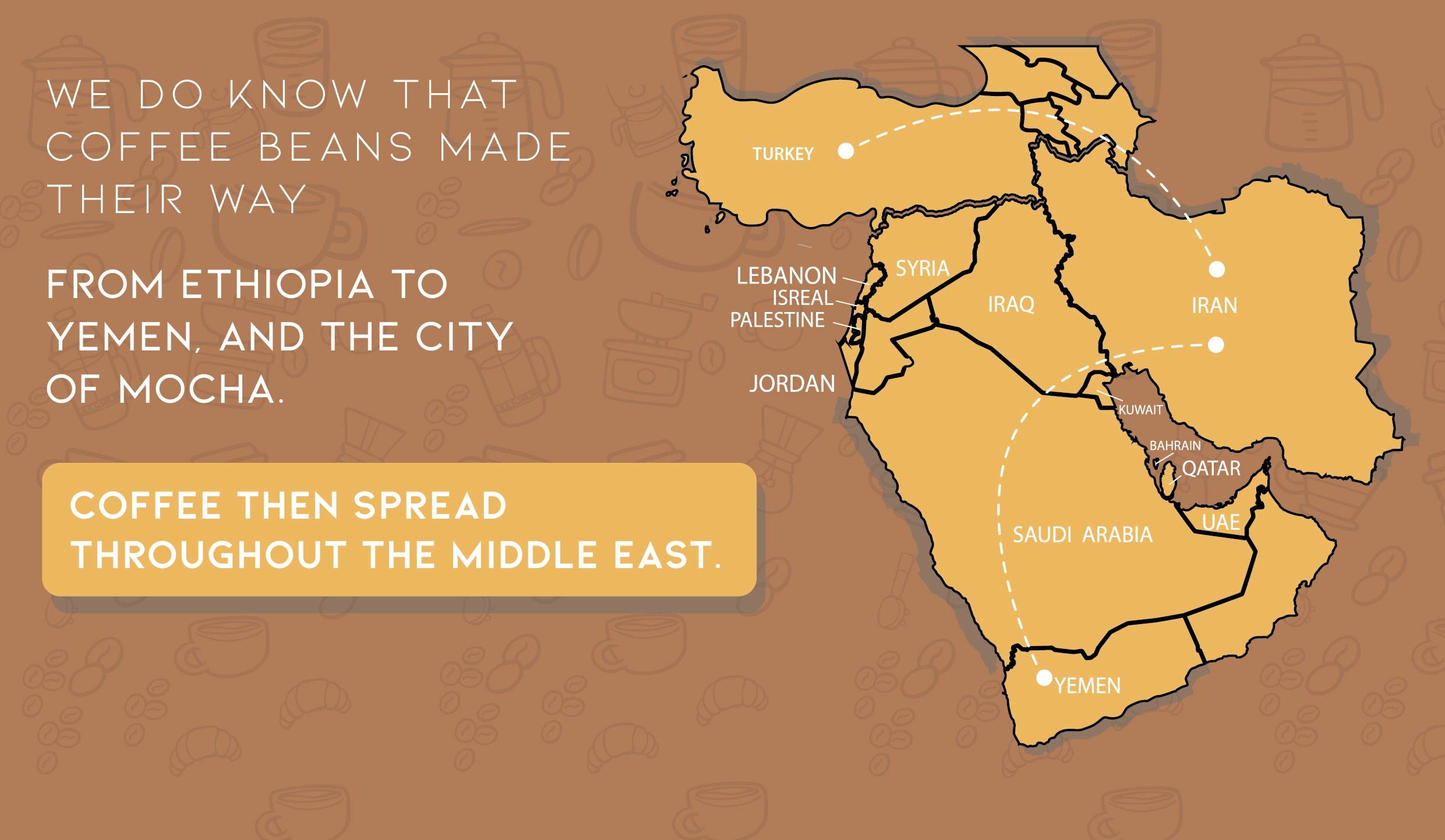
- In the mid-1600s, Coffee finally made it to New York, then known as New Amsterdam.
- Dutch royalty and the traders who served them tried for many years to grow coffee outside of the Arabian peninsula, but it never thrived. In around 1714, however, they finally brought coffee to the Americas where it grew with great enthusiasm.
- Thomas Jefferson declared coffee ‘The favorite drink of the civilized world’.
Coffee Drinking
How do Americans consume coffee — the most popular beverage in the country bar water — and how is that changing? I look at how we drink coffee both at home and outside the home, and how we compare to other countries worldwide.
- According to the NCA 64% of US adults drink coffee daily. That’s the highest level since 2012. Maybe everyone needs a pick-me-up…
- The average American coffee drinker consumes 2.7 cups a day, at 9oz per cup. This means, according to my back-of-a-napkin math, 150 million Americans drink around 400 million cups of the stuff per day! (Kidding about the math, that fact came from investment blog, The Motley Fool).
- Despite this heroic effort, the USA is only number 11 in the world when it comes to per-capita coffee consumption according to the BBC. The top 10 are all mainland European states, with the UK trailing the USA.
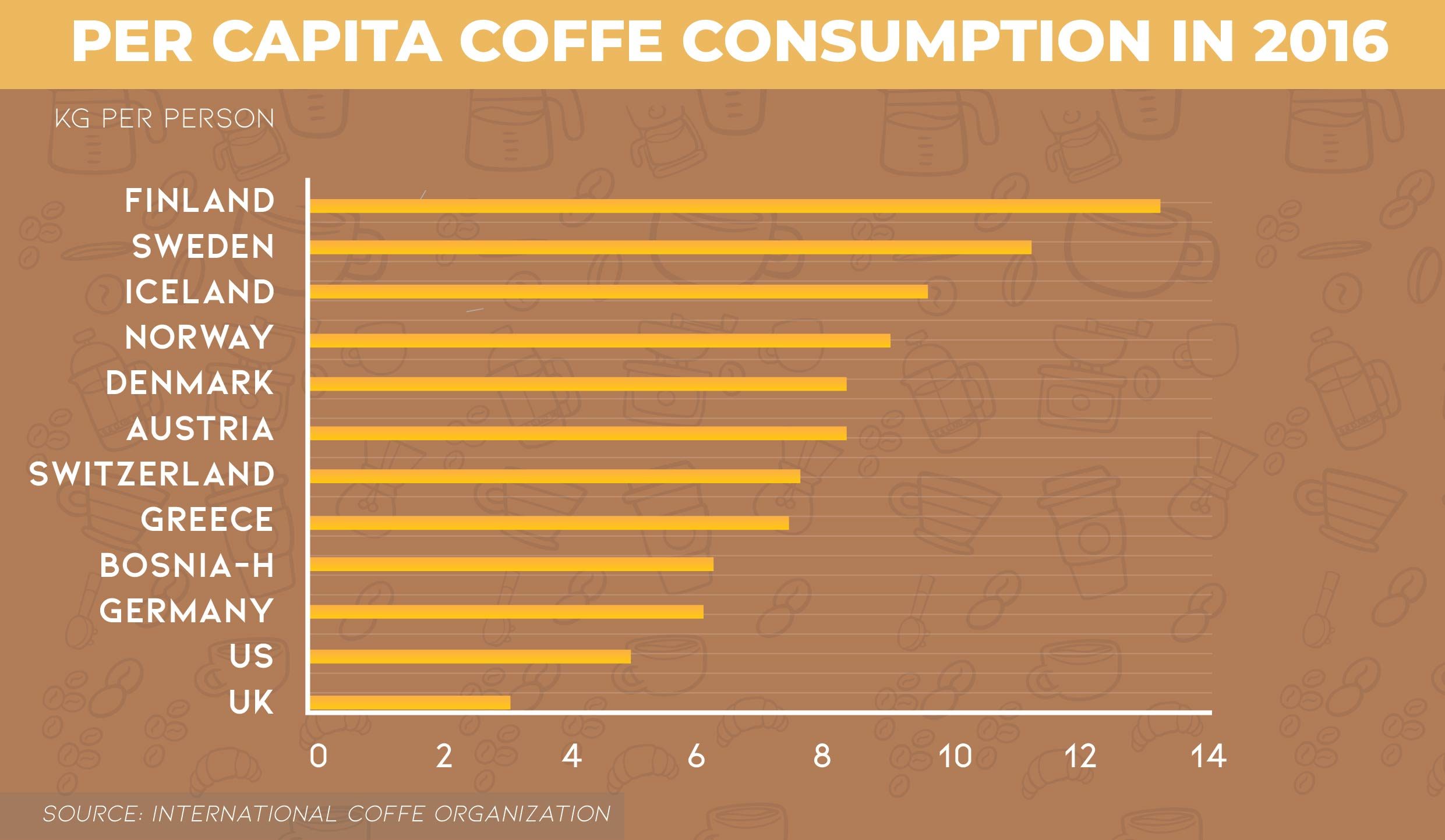
- The USA might not drink as much coffee as some other countries, but boy are American coffee drinkers loyal to their caffeine delivery system! According to the Huffington Post, a whopping 52% of US coffee drinkers would forgo a shower if they had to choose between that and coffee of a morning.
- Americans are also starting to lose their sweet tooth, it seems, as the NCA reports a 66% rise in people adding only milk rather than milk plus sugar or sweetener to their coffee since 2015.
- Coffee has long been said to have health benefits. Recent reports from food scientists and the NCA support that, claiming coffee drinkers may live longer than non-coffee drinkers, are less likely to develop type two diabetes than non-coffee drinkers, may benefit from liver-protective effects (avoid Irish coffees for that one, obviously), and may experience protection from depression
- According, again, to the NCA, there’s a growing love for espresso-based drinks in the USA. Of everyone who drank espresso-based drinks last year, they went for:
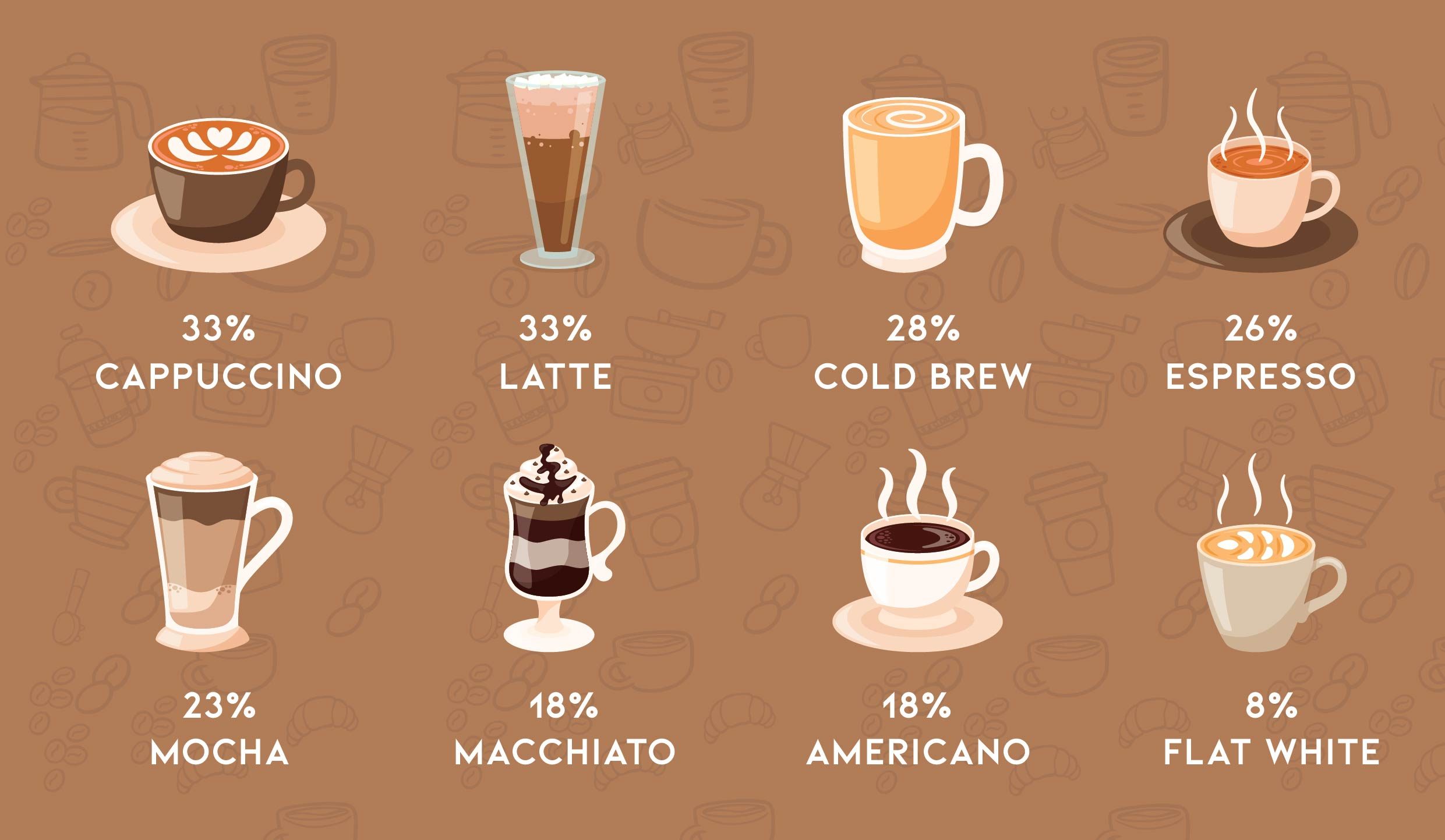
- Stats are different among millennials. The National Coffee Association claims that 70% of the coffee millennials drink is in the form of gourmet, espresso-based beverages. Sounds fancy, but that usually means coffee consumed on the go!
- Overall, in-home coffee prep is waning in popularity though it’s still popular. The NCA’s 2019 report showed that 78% of coffee drinkers make their coffee at home, down from 2012’s 84%
The Machines
As gourmet coffee grows in popularity, the way we make it at home is in flux. Gone are the days of being fine with any brown liquid that wakes us up — with the range of coffee-making equipment now on the market, it’s only a matter of time before every American is a coffee aficionado.
- I’ve talked about this in a couple of articles, but the demise of the drip coffee maker is really interesting! In 2010, a huge 80% of US at-home coffee drinkers relied on a drip coffee machine. Now, that’s down to 45% according to Statista.
- The drip shortfall (the drip… spillage?) has been made up by espresso makers and pod coffee machines with their single-serve goodness. The NCA tells us that the use of single-serve machines is up 50% since 2015.
- Current reports of at-home machines use are:
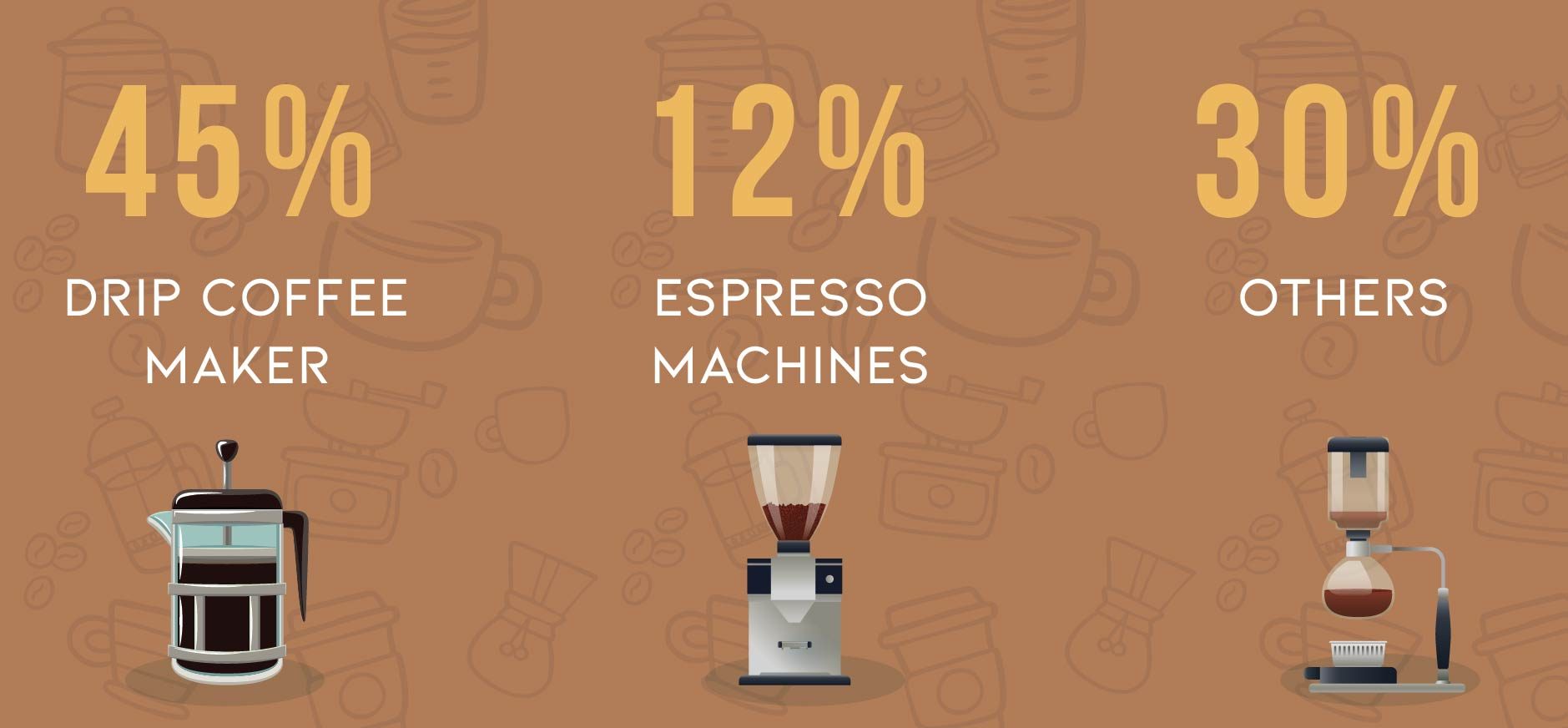
- This is a weird one — only 65% of millennials are aware of single-serve brewing machines. That’s much less than in older age brackets. Is this because millennials grab coffee at work, or from coffee shops on the way? The NCA doesn’t delve into the whys, but we can make educated guesses. Perhaps it’s because not many millennials own homes and make big purchases like kitchen gadgets?
Business of Coffee
Coffee, overall, makes money in the USA. Revenue has been growing every year for over a decade, and yet a few obvious names still control the takeaway coffee market.
- The US coffee industry is worth a cool $96 billion according to Statista.
- Growth has been steady since 2010, as you can see:
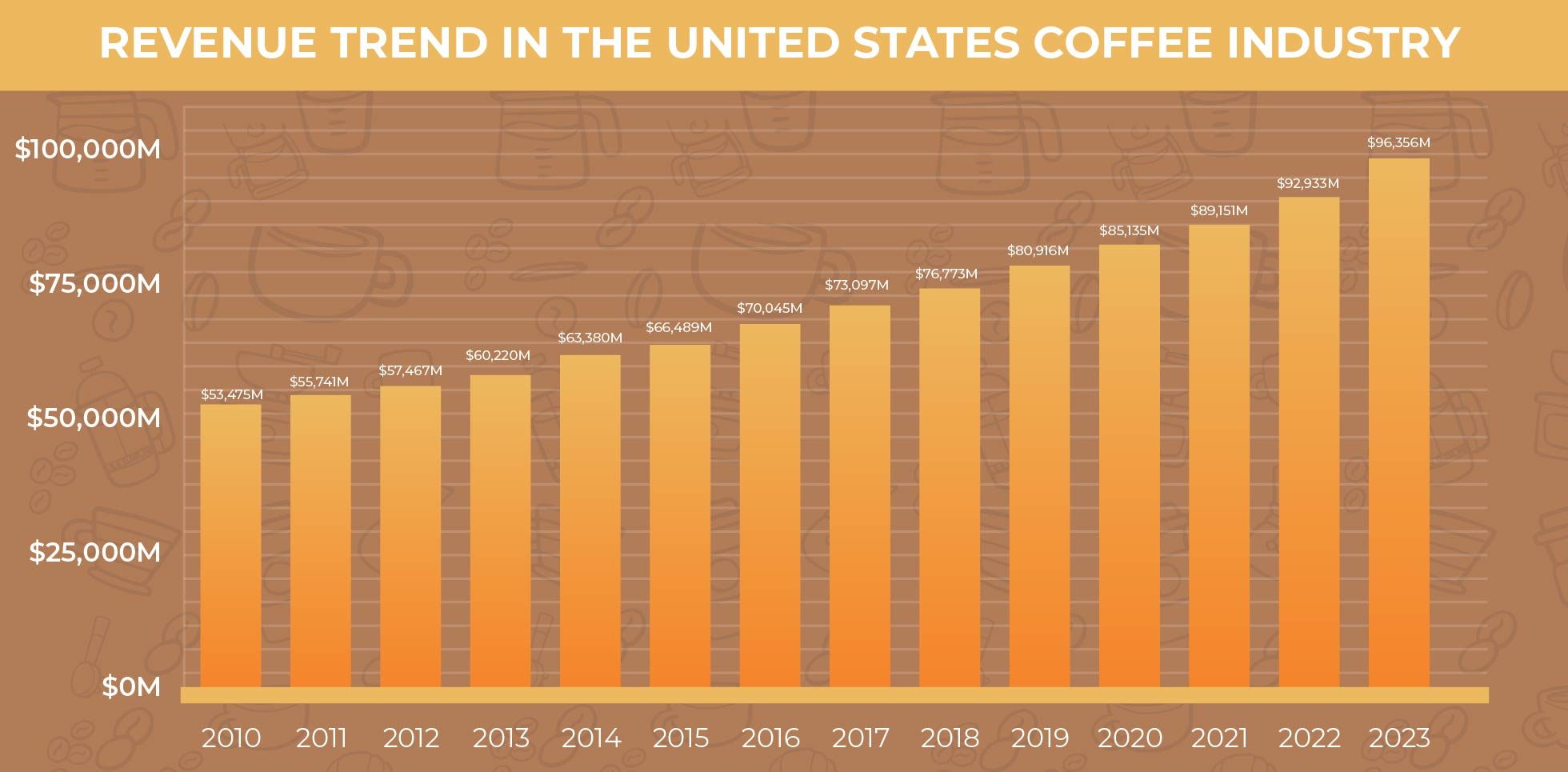
- Our friends at the NCA tell us that a solid half of all coffees consumed by Americans outside of the home were bought at drive-throughs. This is uniquely American, as drive-through coffee shops aren’t popular in many other places.
- According to research carried out by World Coffee Portal, 78% of coffee shops in the USA are part of the Starbucks, Dunkin’ Donuts, or Caribou Coffee chains. That’s a huge share of the market for the big three!
- In 2017, the top coffee brands in the USA were…
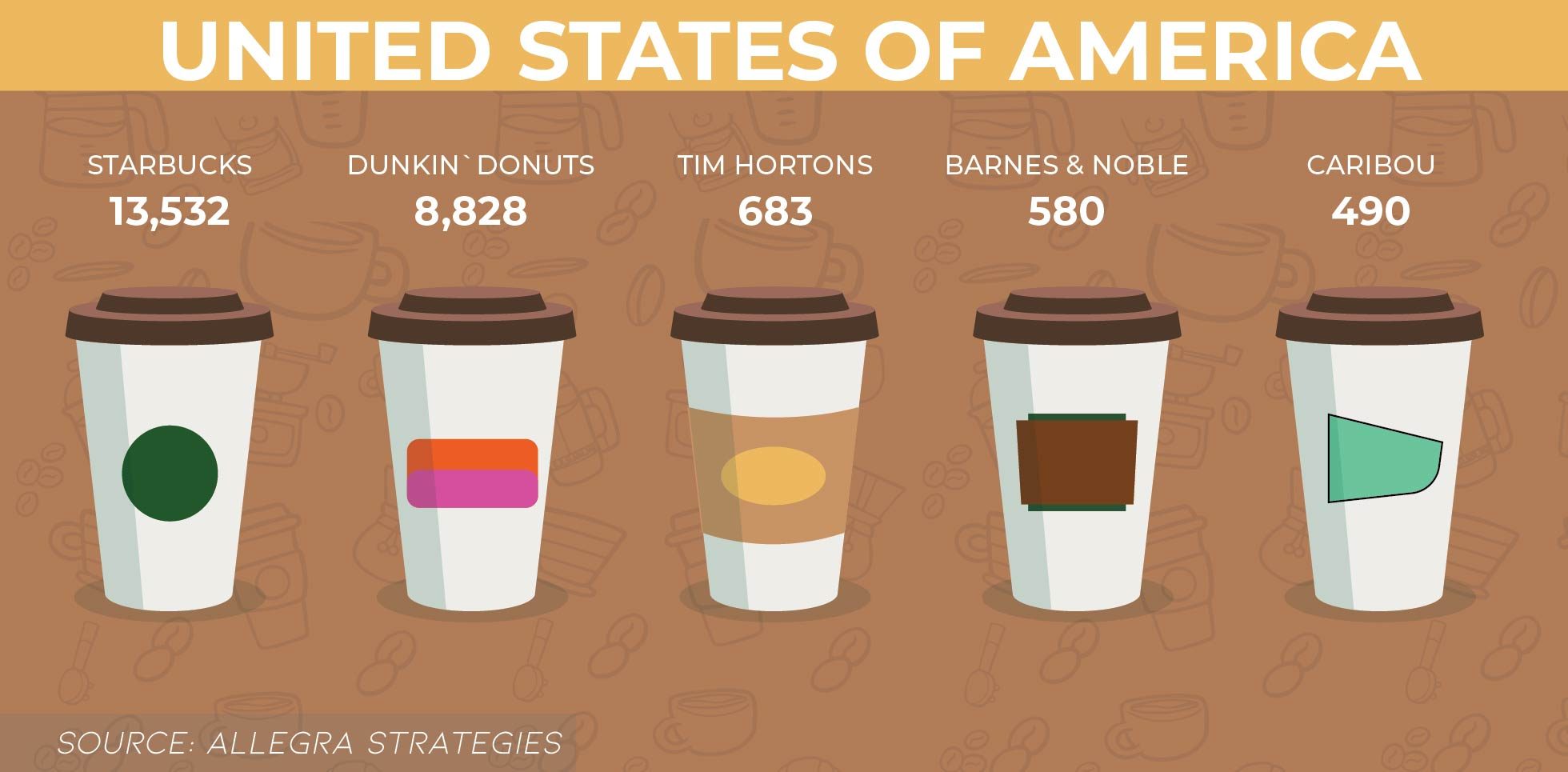
- MarketWatch tells us that the average price of a coffee in the USA across all styles and markets is $2.99. Astonishing, really, when Starbucks charges between $1.95 and $2.15 for a tall filter coffee.
- According to an Amerisleep survey, people over 65 spend just $7 per year in coffee shops on average, despite being far more likely to drink coffee than their younger counterparts. Coffee drinkers aged 25-34, on the other hand, spend an average of $2,000 per year in coffee shops!
Coffee at Work
No matter what your job is, I bet you sometimes get a bit tired towards the end of the day. Or bored. Or want to stretch your legs. Or have a chat with a work friend. Or… well… all the other reasons to get up and head over to the coffee machine!
- Office workers are one of the biggest groups of coffee drinkers in the USA. According to our pals over at Hamilton Beach, the average US office employee drinks 20 cups of coffee per week. Which is a huge 1040 cups per year!
- Interestingly, Europeans drink more coffee at work than people in the USA. There, a whopping 52% of coffee consumed outside the home is drunk in the office. In fact, according to GlobeNewsWire, office coffee consumption is growing in almost every country worldwide.
- While we’re on international work coffee consumption, Italy is interesting. Because they have a coffee bar culture, only 36% of the coffee they drink is enjoyed at work. That’s really low compared to similar European and Latin countries.
- This is a fun one: the average American worker spends about 24 minutes per day making and drinking coffee and wandering to and from the coffee area, according to Statista. Sometimes intentionally slowly if my time in an office is anything to go by. Anyway, over the average working life, that adds up to about 190 days.
- Coffee Business Intelligence also notes that large businesses have big, automatic coffee machines. Smaller businesses have really taken to capsule coffee machines, and that has pushed coffee consumption in the sector.
- The most widely used brewing method at work is still a drip machine, though that’s changing. Drip coffee accounts for 54% of work coffee. Espresso is now a (trailing) second with 24% according to Statista. It seems logical that the rise in pod machines have contributed to espresso being available at work, though I couldn’t confirm the connection.
- Workers who drink coffee are often more productive than those who go without. So you make up for those 190 days. Maybe walk slower next time, or have a longer chat over the Nespresso machine.
- Income (and therefore probably class) has an impact on how much coffee people drink. Of those Americans making under $30k per year, 58% drink coffee. Over $30k, and that number is 66%. But, here’s the twist, lower-income workers who do drink coffee tend to consume a full cup more than their better-paid counterparts. This may have to do with the types of jobs these workers are likely to do, amongst other things.
Coffee Production
After crude oil, coffee is the most sought-after commodity in the world. The coffee plant originated in Ethiopia, but coffee is now grown throughout the global south. Specifically, coffee likes mountainous environments, so the Americas are great for coffee growing. Perhaps that’s why 67% of the world’s coffee comes from there (most notably, Brazil, the world’s biggest producer of coffee)! As our awareness of where our food and drink comes from grows, coffee-lovers are beginning to think more carefully about their drinks’ production and origin.
- The coffee import/export industry is worth over $100bn worldwide.
- According to Business Insider, 90% of the world’s coffee comes from economically developing countries, and growing coffee is the work of 25 million farming families across the world.
- According to the International Coffee Association, over 90% of coffee is exported from its origin countries green. That means roasting takes place elsewhere, adding much of the value of the finished coffee product.
- Green and roasted coffee beans are exported from very different areas of the world:
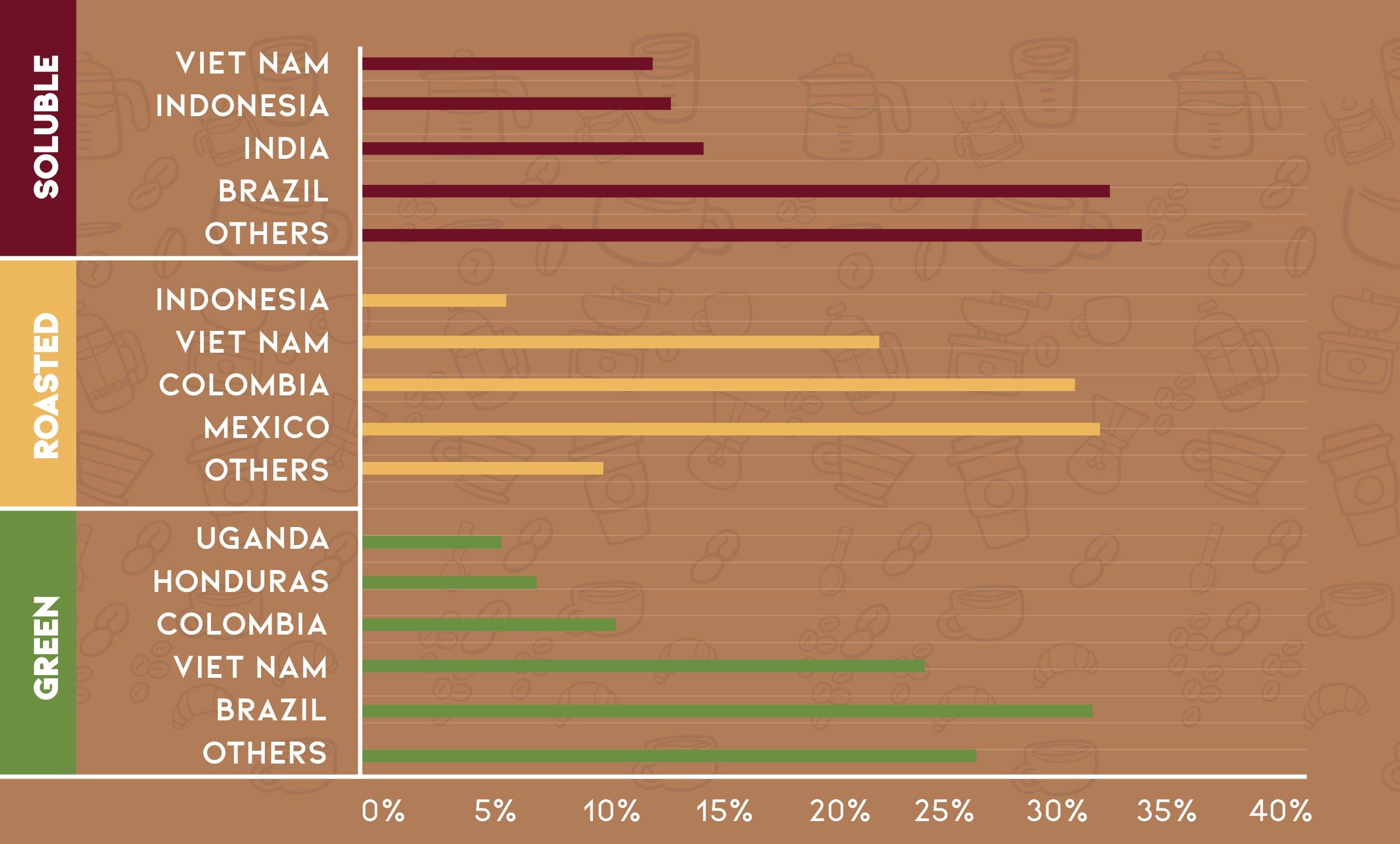
- Americans are split on coffee ethics — the NCA claims that 53% of US coffee drinkers prefer to buy environmentally friendly coffee or coffee which supports farmers, while 47% don’t tend to pay attention to either.
- Here’s a nice little plus — coffee is loved by bees! It’s a favorite plant of our buzzing, pollinating friends, so drink more coffee, and you’re basically helping to save them!
- Mexico has the world’s fastest-growing coffee industry, based on data from 2015-2019 compiled by the USDA:
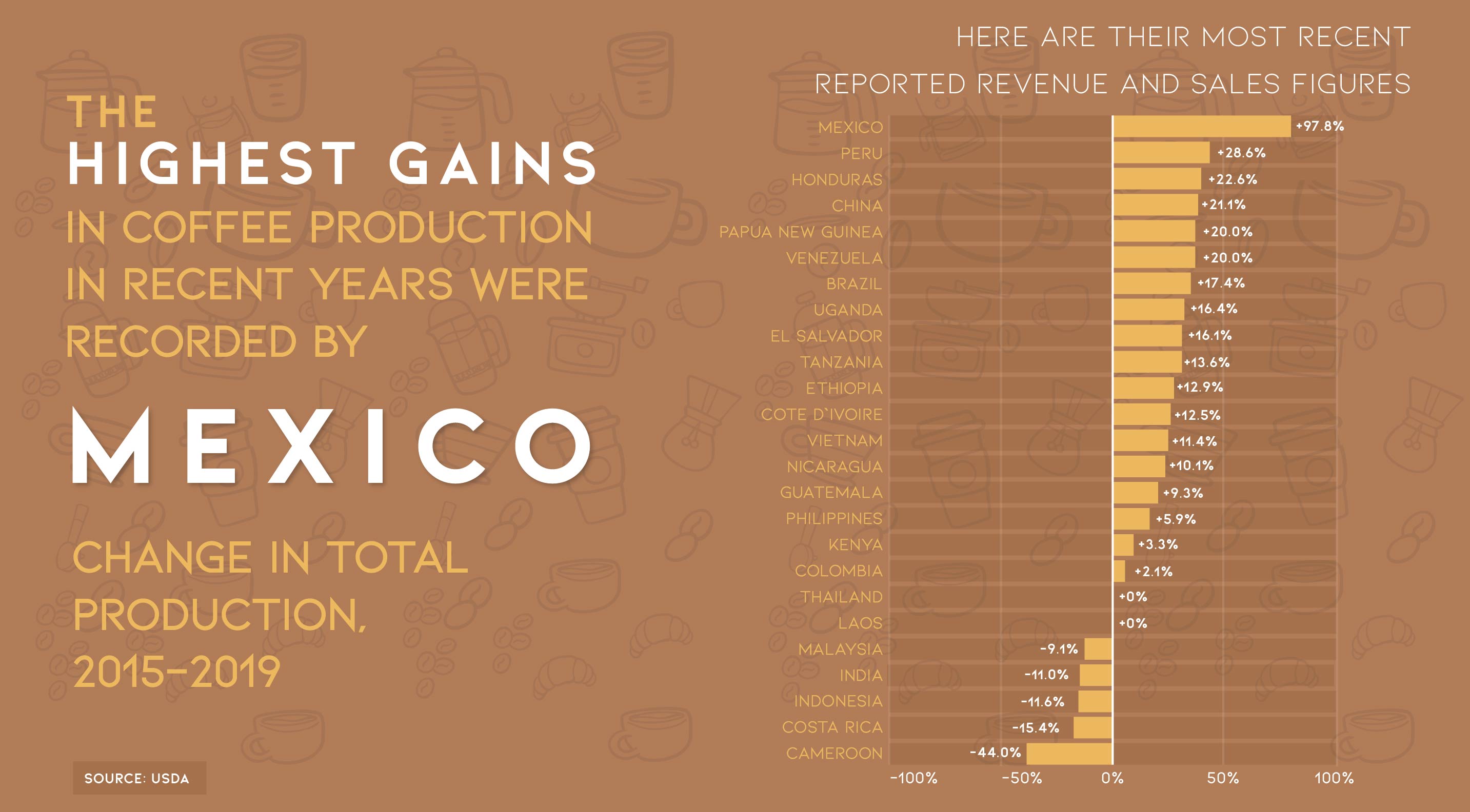
Takeaways (milk and sugar are over by the door)
That was a lot of information, I know. I’ve tried to avoid the really obvious ‘fun facts’ about coffee here and instead looked at coffee production and consumption on a macro level.
Clearly, coffee is a pretty healthy industry. Year after year, revenues are rising, with only a small dip so far for 2020s twists and turns. There are negatives, though, many of the countries that produce the most coffee don’t see much of the money involved in the industry. That’s because the money is at the other end of the supply chain — it’s being made by the companies roasting beans and selling to consumers.
Of course, buying Fair Trade or Rainforest Certified helps, and is something we can all do. Many coffee companies have further schemes for helping farmers, so do look out for those.
In the USA, the way we drink coffee is changing. Older Americans drink a lot of coffee, but they do so at home. Largely, they still rely on drip coffee makers with a notable uptick in the use of single-serve machines too. As millennials make way for Gen Z at the bottom of the age range of coffee drinkers, we’re starting to see that their attitude to coffee is very different.
Millennials don’t make much coffee at home, and they spend a lot in coffee shops. The conclusion usually jumped to here is that millennials are wasteful, but I think they (okay, I admit it, we) are just very short on time. Plus, we spend money on small luxuries rather than large ones.
Perhaps unfortunately, a lot of the money spent on coffee outside the home is still going to a handful of huge umbrella companies. Try to shop local! But you know, I don’t expect to solve late-stage capitalism on my coffee blog…
Over the next few years it will be really interesting to see how Gen Z change things for coffee. There’s a huge awareness of global issues from young people, so there may well be a big push towards further sustainability and fairer trade. That being said, at present Gen Z aren’t huge coffee drinkers. Of course, this may all change when more of them move into the fulltime workforce!
A Few Final Words
Okay, obviously I’m a bit too into coffee: drinking it, thinking about it, reading about it, writing about it… but you have to admit it’s interesting. Until doing research for this piece I had no idea, for example, that coffee is the most valuable export in the world after crude oil. That’s a big fact. Coffee, as a drink and an industry, spans the whole globe. It’s nice to think that you could share a cup of joe with a coffee farmer from Brazil or Vietnam and bond over it. While it’s clear that our attitudes to coffee are changing, with younger people seeing it more as an experience and an artisanal product, we can at least be happy about the fact that it’s clearly around to stay pretty much forever!
References:
- The History of Coffee. Retrieved from The National Coffee Association USA
- The 2020 National Coffee Data Trends Report – the “Atlas of American Coffee”. Retrieved from National Coffee Association USA
- 11 Coffee Stats that Will Blow You Away. Retrieved from The Motley Fool
- Coffee: Who grows, drinks and pays the most?. Retrieved from British Broadcasting Corporation (BBC)
- America’s Coffee Obsession: Fun Facts That Prove We’re Hooked. Retrieved from The Huffington Post
- Domestic consumption of coffee in the United States from 2013/14 to 2018/19. Retrieved from Statista
- What kind of coffee do you usually drink at work/at the office?. Retrieved from Statista
- Coffee preparation options available at work among employees in the United States in 2019, by type. Retrieved from Statista
- Global Coffee Shops Market to be Worth $237.6 Billion by 2025. Retrieved from GlobeNewsWire
- Why the price of your morning coffee could get more expensive. Retrieved from MarketWatch
- The Caffeine Kick. Retrieved from Amerisleep
- 11 Incredible Facts About The Global Coffee Industry. Retrieved from Business Insider
- Monthly Coffee Market Report (2019/20). Retrieved from International Coffee Organization
- Coffee: World Markets and Trade. Retrieved from United States Department of Agriculture
Thanks, I enjoyed reading this! I am a very big coffee drinker and enjoy articles that encourage it!